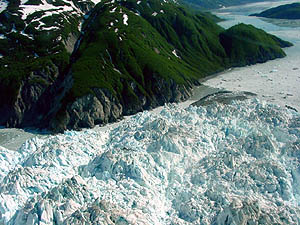 June 19, 2002
"We're working closely with the USGS and the National Park Service to monitor the glacier's movement," Tricia O'Connor, district ranger with the Tongass National Forest's Yakutat Ranger District noted. "This is a unique natural phenomenon, with some potentially serious effects on the local community and National Forest System lands," she added. "We want to be able to predict these effects as far in advance as possible." Trabant, O'Connor, and U.S. National Park Ranger (Wrangell-St. Elias National Park) Jacqueline Lott flew over the glacier on Friday, June 14 and Sunday, June 16. Lott stated that "Those flights have shown that the glacier has narrowed the opening to about 150 feet. Tidal influence in Russell Fiord has been reduced, however there is still seawater flowing between Disenchantment Bay and Russell Fiord". Should an effective ice dam form and remain stable, Russell Fiord will begin to fill with fresh water. The water level will rise until one of two things happens. Either the ice dam will fail, as occurred in 1986, or the lake will fill until it reaches an ancient spillway at the south end
Hubbard Glacier most recently blocked the entrance to Russell Fiord near the end of May 1986. After that closure, freshwater flowing into the fiord raised the level of the lake 84 feet before the ice dam failed about five months later in October 1986. Since 1986, Hubbard Glacier has continued to advance into Disenchantment Bay and Russell Fiord at an average rate of about 105 feet per year, but large tidal currents have kept a channel open between the glacier and hills to the south. The rate of advance across the narrow channel connecting Russell Fiord to the sea has averaged only about 6 meters (~ 20 feet) per year. As occurred during the 1986 closure, the advancing Hubbard Glacier has formed a small push moraine near the closure that has stopped the calving in that area. When calving is stopped, Hubbard advances at about the speed of ice flow near the terminus. Ice near the terminus is flowing about 11 meters per day, according to hydrologist Bob Krimmel of the USGS in Tacoma, Washington. Krimmel determined the ice speeds by analyzing aerial photos and presented the results at an International symposium on fast ice flow, that took place in Yakutat last week.
Note: The USGS serves the Nation by providing reliable scientific information to: describe and understand the Earth; minimize the loss of life and property from natural disasters; manage water, biological, energy and mineral resources; and enhance and protect our quality of life.
Source of News Release & Digital Photos:
|
|||

